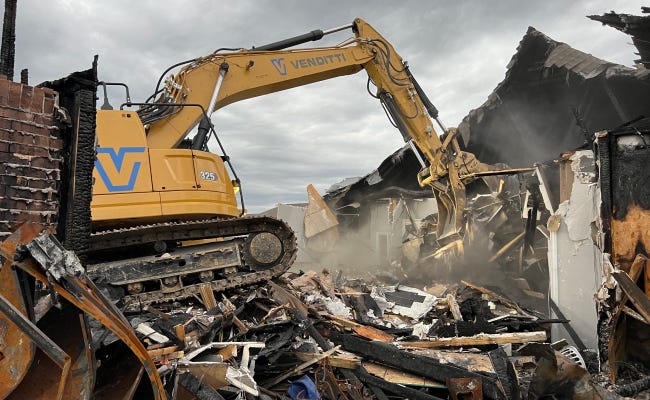The Ultimate Overview to Inside Demolition Techniques and Devices
Within the world of indoor remodellings, the art of demolition is a crucial phase that calls for accuracy, ability, and the right collection of tools. Whether you are an experienced expert or a DIY enthusiast, comprehending the details of indoor demolition techniques can make all the difference in achieving a successful project outcome.
Necessary Interior Demolition Devices
When undertaking interior demolition jobs, having the appropriate tools is essential for effectiveness and safety and security. One of the most essential tools for interior demolition is the demolition hammer. This sturdy device is designed to appear challenging materials like drywall, concrete, and ceramic tile. Its powerful hammering action can quickly demolish walls, floorings, and other structures. Additionally, a lever is essential for removing fixtures, trim, and various other products. Its utilize enables the very easy removal of nails and other fasteners without harming the surrounding surface areas - interior demolition.
An additional vital device is a reciprocating saw, which is excellent for puncturing a range of products such as metal, plastic, and timber. Its ability to make precise cuts in tight rooms makes it optimal for demolition job. Furthermore, an energy knife is essential for reducing products like rug, plastic floor covering, and insulation. Its sharp blade makes sure precise and tidy cuts, helping with the elimination of unwanted products. Overall, having these important interior demolition devices will significantly improve the efficiency and security of any type of demolition job.

Safety Safety Measures Throughout Demolition

Additionally, all employees entailed in the demolition procedure must obtain adequate training on the appropriate handling of tools and equipment to minimize accidents. It is necessary to safeguard the job area by setting up indicators and obstacles to stop unauthorized accessibility - interior demolition. On a regular basis checking and keeping tools and tools can also add to a more secure working setting. By sticking to these safety precautions, indoor demolition jobs can be brought out efficiently while focusing on the health of all people involved.
Techniques for Getting Rid Of Wall Surfaces
Executing correct security precautions throughout indoor demolition projects is essential for producing a safe and secure working environment, and one crucial element of such projects involves understanding methods for getting rid of wall surfaces. One generally used technique is hand-operated demolition, which requires the usage of standard hand devices such as sledgehammers, crowbars, and energy knives to very carefully dismantle the wall piece by item. This strategy permits for better control over the demolition process, especially in delicate locations where accuracy is necessary.
For bigger, a lot more complex wall surfaces, mechanical demolition may be essential. This involves utilizing hefty machinery like excavators or excavators to knock down walls efficiently. Nevertheless, it is essential to ensure that the structural integrity of the structure is not jeopardized during mechanical demolition.
An additional technique for getting Discover More rid of wall surfaces is deconstruction, where the wall surface is disassembled in a manner that protects recyclable products. This lasting strategy is environmentally pleasant and can additionally help in reducing disposal prices. Whichever technique is utilized, it is essential to follow proper safety protocols and think about the architectural effects of wall elimination to guarantee a successful interior demolition task.
Removing Floor Covering Like a Pro
Efficiently removing flooring throughout interior demolition calls for the correct tools and techniques to make sure a smooth and effective process. The initial action in eliminating floor covering is to get rid of the area of any kind of furnishings or obstacles. Next, identify the sort of floor covering to determine the suitable elimination technique. For hardwood or laminate flooring, begin by getting rid of the walls and after that utilize a flooring scrape to lift and detach the planks. Carpeting removal includes reducing the rug into convenient sections and rolling it up for disposal. For tile or plastic floor covering, a carve or floor scraper can be used to pry up the tiles or sheets. It's important to wear safety equipment such as handwear covers, safety glasses, and a mask to stop injuries and exposure to dust and particles. Additionally, having a dumpster or marked disposal area all set for the eliminated flooring products is critical for keeping a clean work atmosphere. By complying with these techniques and making use of the right devices, eliminating floor covering like a pro can be attained effectively and properly.
Correct Waste Disposal Techniques
After efficiently removing flooring making use of the proper tools and methods, the following important step in the interior demolition process is carrying out correct waste disposal techniques. Proper waste disposal is crucial for preserving a safe and clean work atmosphere during and after here demolition.

Professionals must abide by regional regulations pertaining to waste disposal to prevent charges and fines. Making use of professional waste administration solutions can enhance the disposal procedure and make certain conformity with environmental guidelines. By implementing correct garbage disposal techniques, indoor demolition jobs can be completed successfully and sustainably.
Verdict
In final thought, interior demolition requires the usage of vital devices and rigorous security precautions to ensure a safe and effective procedure. By complying with these standards, interior demolition can be finished properly and with very little threats.
One of the most crucial devices for interior demolition is the demolition hammer (interior demolition). In general, having these necessary indoor demolition devices will significantly improve the efficiency and safety of any type of demolition project
Effectively this hyperlink getting rid of floor covering during indoor demolition needs the appropriate devices and strategies to make sure a smooth and successful procedure.After efficiently getting rid of flooring using the appropriate tools and strategies, the next critical step in the indoor demolition process is applying proper waste disposal approaches.In final thought, indoor demolition requires the usage of important devices and stringent safety and security preventative measures to guarantee a risk-free and successful procedure.